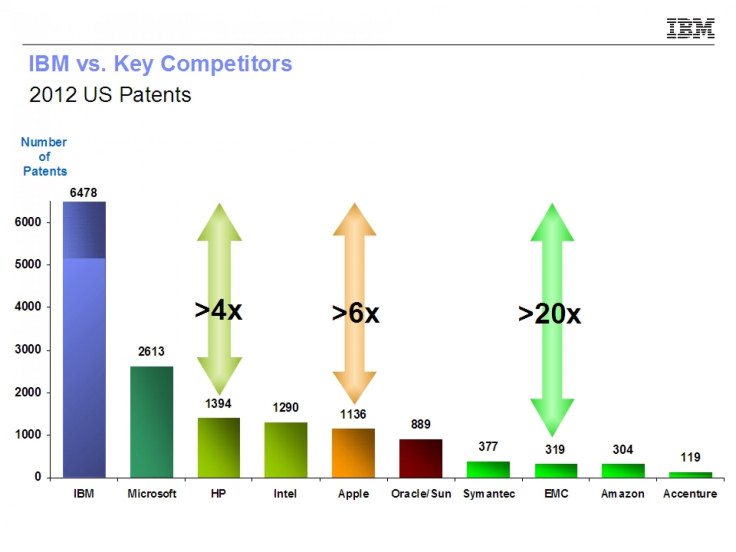Technology Focus: US Falling Behind More In Patent Sweepstakes
IBM May Be Patent King But Samsung And Asian Innovators Right Behind

Last week saw the annual reckoning: International Business Machines Corp. (NYSE:IBM) said it had won 6,478 patents in 2012, more than any other company, continuing its 20-year domination of the technology field.
Only two other U.S. companies appeared on the top 10 list. The news is very good for IBM. The question is, what about the future of Corporate USA?
The two other American companies on the list were Microsoft Corp. (NASDAQ: MSFT), the world's biggest software company, in sixth place, with 2,613 patents, and General Electric Co. (NYSE:GE), the No. 1 conglomerate, with 1,652 patents, in ninth place.
One reassuring point to U.S. investors is that both IBM and GE are more than a century old, while Microsoft is now 33.
But look who else is in the top 10:
In second place was South Korea's Samsung Electronics (KRX:005930), the No. 1 smartphone maker and No. 2 global chipmaker, with 5,081 patents, followed by Japan’s Canon Inc. (NASDAQ:CANNY) with 3,174 and Sony Corp. (NYSE:SNE), with 3,032 patents.
The remaining patent champions were two more Japanese firms, Panasonic Corp. (NYSE:PC), with 2,769, and Toshiba Corp. (PINK:TOSBF) with 2,444; and Hon Hai Precision Industries (TPE:2317) with 2,013 and LG Electronics, with 1,624.
One irony: Hon Hai, of Taiwan, is the biggest contract manufacturer for Apple Inc. (NASDAQ:AAPL), which ranked 22 on the list, with only 1,136 patents.
So the real question is whether U.S. technology can remain competitive over the next 10 years. IBM CEO Virginia Rometty hailed “this benchmark in technological and scientific creativity” even as she noted that 30 percent of the patents were issued to non-U.S. IBM’ers.
So if we reduce IBM’s numbers by 30 percent, Samsung is the world patent king.
To be sure, all the big patent developers are multinationals. In 1968, Raymond Vernon, a professor at Harvard Business School, published his famous article, “Sovereignty at Bay,” in Foreign Affairs, in which he argued that multinationals owe loyalty to no country.
Since then, with computerization and the Internet, new designs and product specifications move worldwide at the speed of light. Where, then, do good new ideas reside?
The big U.S. companies spend fortunes on research. In the first nine months of 2013, IBM, of Armonk, N.Y., reported spending $4.7 billion on research and development, slightly less than in 2011.
Microsoft, of Redmond, Wash., for its year ended June 30, spent $9.8 billion, 8.4 percent more than in 2011, as it finished Windows 8. GE, of Fairfield, Conn., reported spending about $4.6 billion in 2011; it doesn’t release quarterly figures.
Meanwhile, some other top U.S. technology companies, like Hewlett-Packard Co. (NYSE: HPQ). No. 15, and Apple, No. 22 on the patent lists, spent plenty as well. The question is in deriving bang for the buck.
Two years ago, the auction of patents from defunct Nortel Networks caused a frenzy, especially after a syndicate that included Apple, Microsoft EMC Corp. (NYSE:EMC), Research in Motion (NASDAQ:RIMM) and others paid $4.5 billion for 6,000 patents.
That spurred InterDigital Inc. (NASDAQ:IDCC) to auction the entire company and its 20,000 patents for $3.7 billion in a busted auction that left the company valued on Friday at only $1.8 billion. Google (NASDAQ:GOOG), meanwhile, acquired Motorola Mobility Holdings for its 17,500 patents, for $12.5 billion.
At Eastman Kodak (PINK:EKDKQ), a desperate CEO, Antonio Perez, tried to auction a block of 1,100 patents for $3 billion, hoping it would stave off bankruptcy. The effort failed a year ago. Last month, the block finally went to Apple, Google, Facebook (NASDAQ:FB), Samsung, Microsoft, RIM, Adobe Systems (NASDAQ:ADBE) and Amazon.com (NASDAQ:AMZN) – for a mere $525 million.
Imagine: Kodak’s trash, from 135 years of good ideas, becomes treasure for younger companies, all of which value imaging. That may ring true for GE founder Thomas Edison’s famous maxim, “Genius is 1 percent inspiration and 99 percent perspiration.”
© Copyright IBTimes 2024. All rights reserved.












